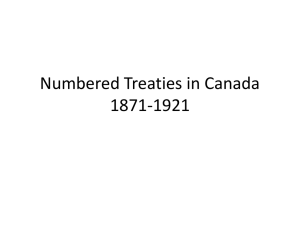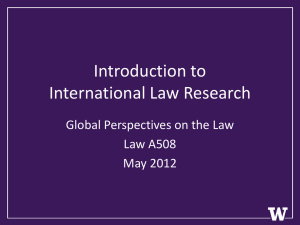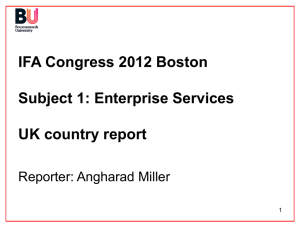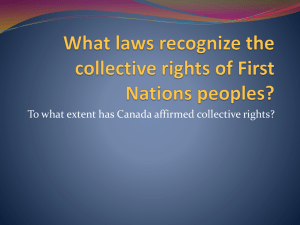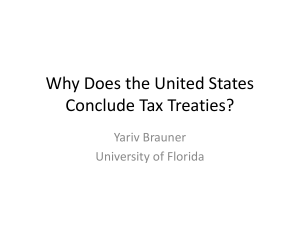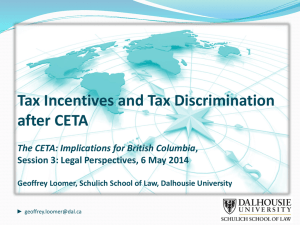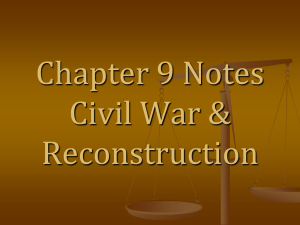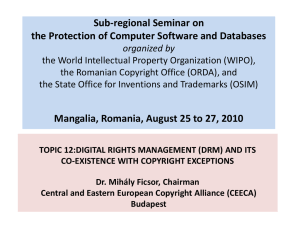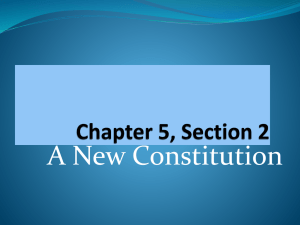Why are treaties binding and why to comply with
advertisement
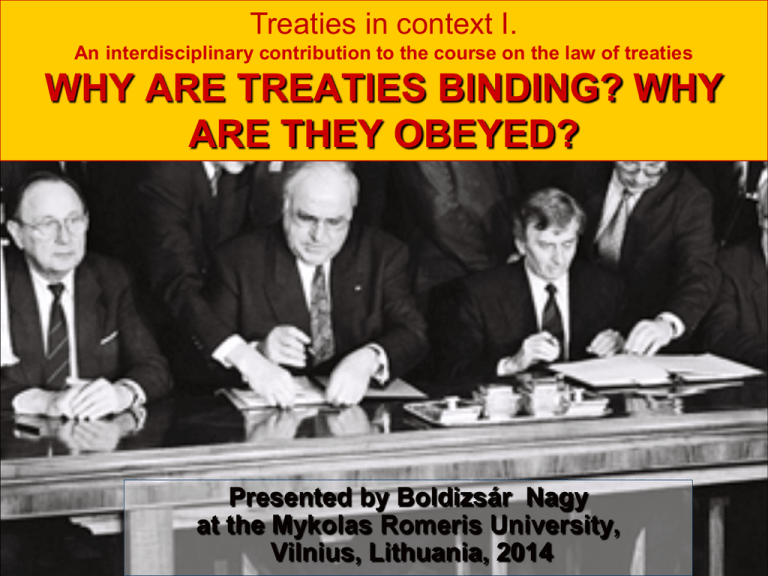
Treaties in context I. An interdisciplinary contribution to the course on the law of treaties WHY ARE TREATIES BINDING? WHY ARE THEY OBEYED? Presented by Boldizsár Nagy at the Mykolas Romeris University, Vilnius, Lithuania, 2014 In place of a motto „On April 9, 1997, John R. Bolton, a former Assistant Secretary of State for International Organization Affairs in the Bush Administration [and US ambassador to the UN in 20052006 – BN], testified before the House International Relations Committee. In his written statement he asserted, »Treaties are 'law' only for U.S. domestic purposes. In their international operation, treaties are simply 'political,' and not legally binding«.„ From: „Treaties as Binding International Obligation” By Frederic L. Kirgis: ASIL Insights May 1997 http://www.asil.org/insights/insight9.htm • Vienna Convention on the Law of Treaties, 1969, preamble „Considering the fundamental role of treaties in the history of international relations, .... Recalling the determination of the peoples of the United Nations to establish conditions under which justice and respect for the obligations arising from treaties can be maintained,.... On the growing role of treaties • No time to wait for the formation of customary law in technically complicated areas (radiocommunication, e.g.) • Conflict between world systems (East- West, North –South, e.g.: arms limitations, environmental protection) • The growing number of states – new states’ wish to form i.l. • Inherent reason: treaties are more precise, allow for clarity of obligation Definition(s) 1969 Vienna Convention on the Law of Treaties Article 2 Use of terms 1. For the purposes of the present Convention: (a)“treaty” means an international concluded between States in written form and agreement governed by international law, whether embodied in a single instrument or in two or more related instruments and whatever its particular designation; Paul Reuter: „A Treaty is an expression of the concurring wills, attributable to two or more subjects of international law, and intended to have legal effects under rules of international law” Introduction to the Law of Treaties, 1989, p. 22 EXPLANATIONS WHY TREATIES (AND INTERNATIONAL LAW) ARE BINDING Theories based on state will Normativistneopozitivist (Hans Kelsen) Unilateral self limitation (G. Jellinek) Merger of wills (H. Triepel P. Reuter, G.I. Tunkin) Natural law school (A. Verdross, H. Lauterpacht) Common consent R. Jennings COMPLIANCE THEORIES EXPLANATIONS WHY TREATIES (AND INTERNATIONAL LAW) ARE OBEYED Sociological, Politological, IR approaches Realists H. Morgenthau, H. Bull, R. Posner Functionalists / Liberal Institutionalists R. Falk, A.M. Slaughter Determinacy Symbolic validation (Andrew.T. Guzman) Thomas Franck’s legitimacy pull Coherence Rational choice Adherence to „secondary norms” Reciprocity Reputation Retaliation COMPLIANCE THEORIES EXPLANATIONS WHY TREATIES (AND INTERNATIONAL LAW) ARE OBEYED Managerial Model A. Chayes and A.H. Chayes Norms Negotiated in pursuance of state interest + consent to be bound Transparency Clear meaning of rules and procedures Transparent action of players Verification and Monitoring Bilateral Multilateral (IO) Reporting and Data Collection May induce domestic compliance +leads to transparency Active management of treaties Capacity building Dispute settlement Amendment and modification of obligations EXPLANATIONS WHY TREATIES (AND INTERNATIONAL LAW) ARE BINDING Harold H. Koh „Transnational Legal process” Oona A. .Hathaway „Integrated theory of compliance” 1 Interaction initiated 2 Generation and interpretation of norms by transnational actors 3 Internalisation of the interpretation through repetition and introduction in the domestic sphere – identity formation Codification Adopted Conventions • 1969. Vienna Convention on the Law of Treaties (concluded by States) Entry into force: 27 January 1980. In Fall 2014 it had 114 parties. • 1986. Vienna Convention on the Law of Treaties between States and International Organizations or between International Organizations Fall 2014 32 states expressed consent to be bound and 12 intergovernmental organisationswere parties. 35 states are needed to enter into force • 1978. Vienna Convention on Succession of States in respect of Treaties – Entry into force: 6 November 1996. In Fall 2014 it had 22 parties • Texts not yet adopted or not constituting binding agreement • Guide to Practice on Reservations to Treaties, 2011 • Draft articles on the effects of armed conflicts on treaties, 2011 • Treaties over time/Subsequent agreements and subsequent practice in relation to interpretation of treaties (in progress since 2008) • The provisional application of treaties (in progress since 2012) Literary hints • • • • • • • • • Burgstaller, Markus (2005): Theories of Comlpliance with International Law, Martinus Nijhoff, Leiden/Boston Chayes, Abram & Chayes, Antonia Handler (1995): The New Sovereignty: Compliance With International Regulatory Agreements Harvard Univ press Delcourt, Barbara: Compliance Theory, MPEPIL, online, visited: October 2014 Franck,Thomas M. (1990).: The Power of Legitimacy among Nations, OUP, New York, Oxford Guzman, Andrew T. : A Compliance-Based Theory of International Law, 90 Cal. L. Rev. 1823 (2002). Available at: http://scholarship.law.berkeley.edu/californialawreview/vol90/iss6/2 Guzman, Andrew.T. (2008), How International Law Works, New York: Oxford University Press Guzman Andrew T. (2009): How international law works: introduction International Theory (2009), 1:2, 285–293 Hathaway, Oona A.: "Between Power and Principle: An Integrated Theory of International Law„ 72 U. Chi. L. Rev. 469 2005 http://digitalcommons.law.yale.edu/fss_papers/836 Koh, H.H. (1997), ‘Why do nations obey international law?’, Yale Law Journal 106: 2599–2659.http://digitalcommons.law.yale.edu/fss_papers/2101 Thanks! Boldizsár Nagy Eötvös Loránd University and Central European University Budapest www.nagyboldizsar.hu

